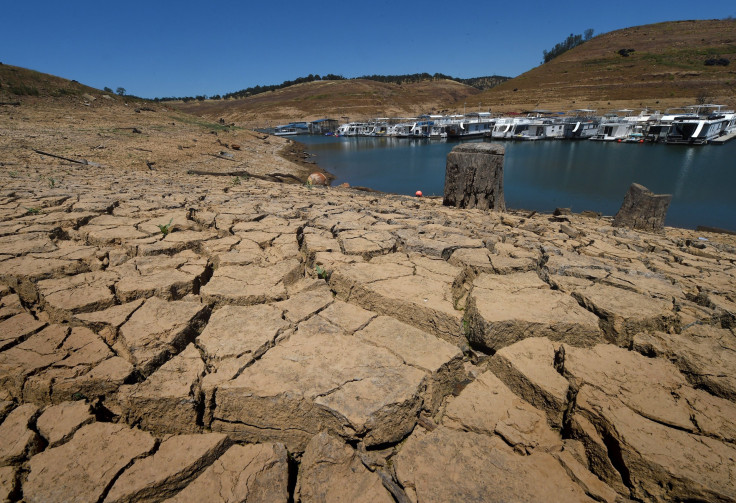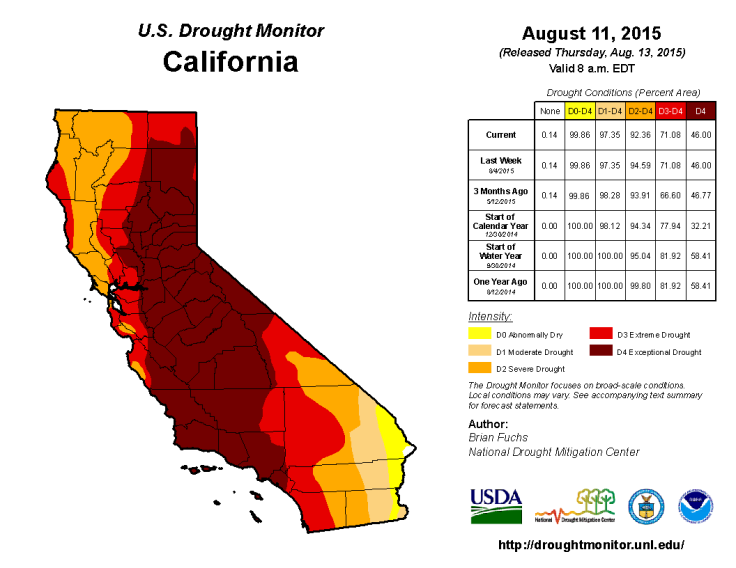Climate Change Is Deepening California's Drought Crisis By As Much As One-Quarter, Study Finds

As California’s drought plows into its fourth year, scorching crops and sucking wells dry, many people are wondering: Is this a normal weather event, or is it a sign of global warming? Scientists say they’ve now determined that human activity is causing as much as one-quarter of the brutal drought.
The findings are the first to quantify just how much the planet’s rising temperatures are exacerbating California’s drought conditions. The study from Columbia University’s Lamont-Doherty Earth Observatory in New York raises an alarm for the Golden State and other arid regions, where water reserves are vanishing as grounds grow parched.
“In coming decades, droughts will continue to be worse than they would’ve been otherwise,” said Park Williams, a bioclimatologist at the observatory and lead author of the study. “And that worsening is going to continue to intensify.”
California’s economy is on track to lose $2.7 billion this year as the drought kills crops, cuts farming and food processing jobs and raises the costs of procuring water and doing business, the Center for Watershed Sciences at the University of California, Davis, said Wednesday in a new report. The state's economy lost an additional $2.2 billion due to the drought in 2014, or roughly 2 percent of California's overall gross domestic product.
Residents and businesses are meanwhile grappling with severe restrictions on their water usage. Gov. Jerry Brown in April ordered the state’s first-ever mandatory water cutbacks, requiring a 25 percent reduction in urban consumption. He made the announcement as California’s snowpack, a critical source of fresh water, measured at just 5 percent of its average levels.
“We’re in a historic drought, and that demands unprecedented action,” Brown said at the time.

Average temperatures in California have crept up by 2.5 degrees Fahrenheit over the last century as global greenhouse gas emissions soar. That extra heat has sucked moisture from California’s plants and soil into the air. Although much of the current drought is caused by the staggering lack of rainfall and natural cyclical weather patterns, the dried-out soil is adding another painful dimension, Williams said.
“A lot of people think that the amount of rain that falls out of the sky is the only thing that matters,” he said. “But warming changes the baseline amount of water that’s available to use, because it sends water back into the sky.”
Williams and the other scientists studied multiple sets of climate data for the study. They found that between 8 to 27 percent of California’s drought is caused by global warming, although the most likely range is 15 to 20 percent, according to the study published this week in the journal Geophysical Research letters.
That means even if California’s rainfall returns to normal -- which it may do by next spring -- the ground will never fully recover from drought conditions, making it harder for the state to endure subsequent droughts. “Wetter years will not be as wet as they were in the 1900s, and the driest years will be a whole lot drier. Already we’re seeing this,” Williams said. “This study gives us the first glimpse at how far along we are on that trajectory.”
Intensifying droughts will only worsen a related development around the world: Disappearing groundwater. Humans are rapidly depleting roughly one-third of the world’s largest aquifers, with the top three most stressed groundwater basins in the Middle East, the border of India and Pakistan and northern Africa, a study by University of California, Irvine, recently found.
Water scarcity is likely to worsen existing political tensions in those regions, security experts warn, particularly as the global population explodes to a projected 11 billion people by 2100.
In California, excessive pumping of groundwater over decades is causing parts of the central San Joaquin Valley to sink into "bowls," a NASA study found Wednesday. The sinking of nearly 2 inches per month could damage bridges, roads and aqueducts, the California Department of Water Resources warned in a statement about the report.
Drought conditions are also straining business operations globally, as companies face shrinking water supplies for their factories and operations, tougher conservation limits and rising utility costs. About one-fifth of the Fortune Global 500 companies that responded to a CDP survey last year said water issues will constrain their growth plans within the next three years, said Cate Lamb, who heads the water program at CDP, a sustainable business advocacy group.

In the U.S., agribusiness giant Cargill Inc. closed a beef-harvest facility in Milwaukee in 2014 and said it would shutter a corn-milling feed facility in Tennessee this year after drought in the U.S. Southwest helped push the nation’s beef-cattle herd down to its lowest level in more than 60 years. In April, Coca-Cola scrapped plans for an $81 million bottling plant in southern India because of opposition by local farmers, who feared the facility would strain groundwater supplies.
“Water insecurity is already stranding assets,” Lamb said. “There’s a strong and growing number of examples of how this issue is having a material effect on business profitability now.”
Guilio Boccaletti, the global managing director for water programs at the Nature Conservancy, a major conservation group, said studies like the Earth Observatory's California drought report are vital for helping companies and countries adapt to the changing climate.
“It’s like the planet is the patient, and these scientists are like doctors trying to diagnose what’s going on,” he said. “The scientists are building our skills to attribute symptoms to the cause. This is incredibly important if you want to manage the cure.”
© Copyright IBTimes 2024. All rights reserved.











